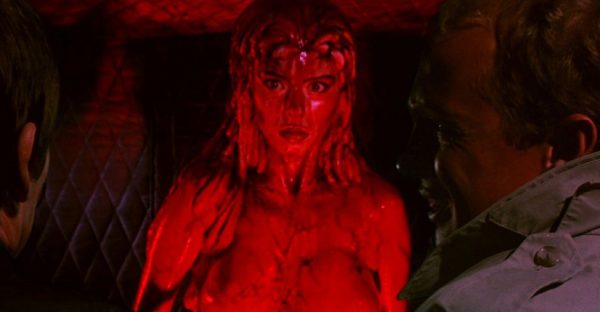A look back at Cannon Films and their search for critical acclaim which led to some memorable successes and failures…
When aficionados think back to the glory days of Cannon Films, most notably in the peak years under Menahem Golan and Yoram Globus, they invariably cast their minds to unashamedly schlocky and low-budget genre fare like Bloodsport, Masters of the Universe and Lifeforce. Golan and Globus acquired Cannon, a slightly unfashionable indie production company with a few films of note such as Joe, starring Peter Boyle. It was the classic little film done good with box office and critical success for a film costing only $106,000, though ironically somewhat removed from some of the more titillating material Cannon produced under Messrs Dennis Friedland and Chris Dewey.
In their early days as Cannon overlords, Golan and Globus continued to produce cheap erotic films (and a trend that continued throughout their run, even as they broadened their range). The group also made indulgent oddities like the musical Apple (directed by Golan himself). The purveyors of B movie exploitation flicks and low-budget riffs on popular entertainment found a unique way to create and distribute independent movies. They really upset the Hollywood elite studios along the way.
Soon stars on the wane like Charles Bronson were brought in to headline Cannon tentpoles, whilst they perpetually tried to find action rivals to some of the rising stars of the era. Chuck Norris was well established but became a Cannon staple before they attempted to make younger stars like Michael Dudikoff and Jean-Claude Van Damme the next big things. Cannon did everything from pumping out Mad Max and Conan the Barbarian clones produced in Italy (and utilising some surprisingly high-profile Giallo specialists) to jumping on a brief ninja craze during the 80s. Not to mention some slightly bigger fare inspired by films like Star Wars and Alien, the lite Cannon equivalents of which were Masters of the Universe and Lifeforce.
They were an odd mix of ambition and almost endearingly lazy. Films had a weird yin-yang of sometimes looking both cheap and impressive, most personified in something like Lifeforce. Indeed Cannon would often look at the VFX departments from hit movies, or high-profile composers in order to add quality to their productions, if not quite the budgets afforded to the likes of Richard Edlund or Ennio Morricone on bigger productions. Likewise, they realised there was a sure-fire way of getting big names to their studio, in spite of occasionally slipshod productions and “bad” scripts. Yes, money. Pay enough and someone like Sly Stallone at his box office peak powers would happily come over to Cannon’s yard to play and the Go-Go boys (Golan and Globus) would feel assured of a hit.
SEE ALSO: Lifeforce: A Film Only Cannon Could Have Made
For the most part, though, something was evading Golan and Globus. It was critical acclaim and awards. Despite memorable appearances at Cannes to promote their wares and hobnob in style, they rarely had anything that might make critics and high-brow naysayers take them seriously. Thus another scheme was dreamt up. Grab iconic directors from indie and world cinema, ideally those on the wane or struggling to get their indulgent ideas financed.
In 1984, one of the biggest coups in Cannon history was getting trailblazing indie director John Cassavetes to make Love Streams under the Cannon label. The film won the Golden Bear at the Berlin Film Festival and was greeted with widespread critical acclaim, with many lauding it as one of Cassavetes’ finest works. Yet none of the acclaim ever found its way to the studio that financed the film and gave Cassavetes carte blanche. As they would find in a few further successes, the brilliance of those works was often deemed in spite of Cannon’s involvement.
It didn’t always work out for the company though, with big Opuses like Sahara proving disastrous and supposed high-brow arthouse films like Bolero deemed trashy. Aside from Cassavetes, Cannon also allowed Robert Altman, alongside screenwriter (and star) Sam Shepard to make Fool for Love, which didn’t have anything like the same success as Love Streams. They also dipped into Europe to prise some of the acclaimed filmmakers of the time away to work with them, like Andrei Konchalovsky, who was seen as a successor to the late Andrei Tarkovsky and had already experienced success with his breakout films.
For Cannon, Konchalovsky made Duet for One and Shy People. The former received a solid response but the latter was greeted more tepidly. Yet, his other film for Cannon (the first of the three) remains the most memorable, and ironically one which was far more in line with Cannon’s action-centric fare between 1984-1989. Runaway Train picked up three Oscar nominations and a lasting legacy, though ironically despite blending Cannon’s artistic aspirations with their commercial genre specialism, the film flopped at the box office.
SEE ALSO: Runaway Train: From Russian Arthouse to The Cannon Group
One of the most surprising names to be associated with Cannon is Jean-Luc Godard, one of the most influential directors of his age and a significant force in the French New Wave. You could perhaps understand Cassavetes being lured by an indie company on home turf, wanting to give him carte blanche, but Godard being tempted from France baffled many, not least the choice to adapt Shakespeare with his iconoclastic version of King Lear.
Diving in and out of the text and forgoing conventional structure (in fairness that may have been expected of Godard), his version was greeted with bafflement. It’s almost aggressively chaotic and a complete antithesis to a film like Ran which took a far more linear approach to adapting the classic text with its own distinctly Kurosawa-ian flavour. Yet, in time, because it’s such a cinematic oddity, Godard’s King Lear has been reappraised in some corners and the bizarrely eclectic cast (including Burgess Meredith, Peter Sellars and Molly Ringwald) makes it, if nothing else, fascinating.
In addition to Shakespeare and the theatre work of Sam Shepard, Cannon weren’t averse to adaptations of high-profile authors and poets as they sought award-magnetising ideas. Alexander Ramati was given full control to adapt his book, The Assisi Underground, telling the story of a Priest’s efforts to hide 300 Jews in Assisi during the Second World War. The resultant film was certainly no Schindler’s List and was torn apart by critics.
More successful was Barfly, which initially didn’t capture much of an audience, but has become revered in time. Directed by a Godard protege and written by infamous poet, Charles Bukowski, Barfly’s listlessness initially alienated audiences before they hooked into the meaning behind it in a film largely based on Bukowski’s own life. Rising star Mickey Rourke shines opposite one of the best actresses of her generation, Faye Dunaway. Rourke as the aspiring but persistently drunk poet, scrawling his ideas down forms a complex connection with Dunaway’s self-professed barfly. Occasionally tragi-comic but always filled with great dialogue, Barfly probably evaded the kind of award recognition it truly deserved, even if Dunaway did receive a Golden Globe nomination.
Barfly came in 1987 a year that proved defining for Cannon, exemplified by two big (for them) budget box office failures in Masters of the Universe and Superman IV: The Quest for Peace. It meant the proverbial tightening of the belt and in the final two years as the company sank further, the budgets shrank. Golan and Globus were also becoming less inclined to seek the critical adoration that had only been teased to them. Films like King Lear were proving to be more costly than they were worth and for the most part, the directors with free reign, untethered, were indulgent to the detriment of the films. Even those positive exceptions were unable to garner a good financial return.
Cannon focused on lower-budget genre fare, though not before Golan himself returned to the director’s chair for a final indulgence. The beefy budget film, Hanna’s War was a commercial disaster with a middling critical reception. Golan was a serviceable director with some highlights, though the original choice, Peter Weir would surely have eeked out the film’s drama with a bit more skill. A year after the film, Cannon were effectively dead.
Golan and Globus briefly skewed the company in two directions under new banners but neither new iteration proved successful and the final nail in Cannon came in 1994 (by which time they were mostly producing straight-to-video films). Still, despite the bizarre mix of films Cannon put out, their attempts at tickling the higher-brow audiences still yielded films like Barfly and Love Streams.
What are your thoughts on Cannon Films? What is the best film they ever produced? Let us know on our social channels @flickeringmyth.
Tom Jolliffe is an award-winning screenwriter and passionate cinephile. He has a number of films out around the world, including When Darkness Falls, Renegades (Lee Majors and Danny Trejo) and War of The Worlds: The Attack (Vincent Regan), with more coming soon including Cinderella’s Revenge (Natasha Henstridge) and The Baby in the Basket (Maryam d’Abo and Paul Barber). Find more info at the best personal site you’ll ever see here.



















